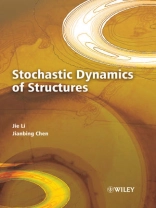In
Stochastic Dynamics of Structures, Li and Chen present a unified view of the theory and techniques for stochastic dynamics analysis, prediction of reliability, and system control of structures within the innovative theoretical framework of physical stochastic systems. The authors outline the fundamental concepts of random variables, stochastic process and random field, and orthogonal expansion of random functions. Readers will gain insight into core concepts such as stochastic process models for typical dynamic excitations of structures, stochastic finite element, and random vibration analysis. Li and Chen also cover advanced topics, including the theory of and elaborate numerical methods for probability density evolution analysis of stochastic dynamical systems, reliability-based design, and performance control of structures.
Stochastic Dynamics of Structures presents techniques for researchers and graduate students in a wide variety of engineering fields: civil engineering, mechanical engineering, aerospace and aeronautics, marine and offshore engineering, ship engineering, and applied mechanics. Practicing engineers will benefit from the concise review of random vibration theory and the new methods introduced in the later chapters.
‘The book is a valuable contribution to the continuing development of the field of stochastic structural dynamics, including the recent discoveries and developments by the authors of the probability density evolution method (PDEM) and its applications to the assessment of the dynamic reliability and control of complex structures through the equivalent extreme-value distribution.’
— A. H-S. Ang, NAE, Hon. Mem. ASCE, Research Professor, University of California, Irvine, USA
‘The authors have made a concerted effort to present a responsible and even holistic account of modern stochastic dynamics. Beyond the traditional concepts, they also discuss theoretical tools of recent currency such as the Karhunen-Loeve expansion, evolutionary power spectra, etc. The theoretical developments are properly supplemented by examples from earthquake, wind, and ocean engineering. The book is integrated by also comprising several useful appendices, and an exhaustive list of references; it will be an indispensable tool for students, researchers, and practitioners endeavoring in its thematic field.’
— Pol Spanos, NAE, Ryon Chair in Engineering, Rice University, Houston, USA
Table of Content
Foreword xiii
Preface xv
1 Introduction 1
1.1 Motivations and Historical Clues 1
1.2 Contents of the Book 5
2 Stochastic Processes and Random Fields 7
2.1 Random Variables 7
2.1.1 Introduction 7
2.1.2 Operations with Random Variables 8
2.1.3 Random Vectors 12
2.1.4 Decomposition of Correlation Matrix 16
2.2 Stochastic Processes 17
2.2.1 Specification of Stochastic Processes 17
2.2.2 Moment Functions of a Stochastic Process 19
2.2.3 Spectral Description of a Stochastic Process 23
2.2.4 Some Operation Rules about Expectation, Correlation and Spectrum 25
2.2.5 Karhunen–Loeve Decomposition 27
2.3 Random Fields 29
2.3.1 Basic Concepts 29
2.3.2 Correlation Structures of Random Fields 31
2.3.3 Discretization of Random Fields 32
2.3.4 Decomposition of Random Fields 34
2.4 Orthogonal Decomposition of Random Functions 36
2.4.1 Metric Spaces and Normed Linear Spaces 36
2.4.2 Hilbert Spaces and General Orthogonal Decomposition 37
2.4.3 Orthogonal Decomposition of Random Functions 40
3 Stochastic Models of Dynamic Excitations 43
3.1 General Expression of Stochastic Excitations 43
3.1.1 Dynamic Excitations and Modeling 43
3.1.2 Models of Stationary and Nonstationary Processes 44
3.1.3 Random Fourier Spectrum Model 46
3.2 Seismic Ground Motions 48
3.2.1 One-Dimensional Model 48
3.2.2 Random Field Model 50
3.2.3 Physical Stochastic Model 53
3.3 Fluctuating Wind Speed in the Boundary Layer 56
3.3.1 Structural Wind Pressure and Wind Speed 56
3.3.2 Power Spectral Density of Fluctuating Wind Speed 58
3.3.3 Random Fourier Spectrum of Fluctuating Wind Speed 60
3.3.4 Random Fourier Correlation Spectrum 63
3.4 Wind Wave and Ocean Wave Spectrum 65
3.4.1 Wind Waves and Wave Forces 65
3.4.2 Power Spectral Density of Wind Waves 68
3.4.3 Direction Spectrum 70
3.5 Orthogonal Decomposition of Random Excitations 72
3.5.1 Orthogonal Decomposition of a Stochastic Process 72
3.5.2 Hartley Orthogonal Basis Function 74
3.5.3 Orthogonal Expansion of Seismic Ground Motions 75
3.5.4 Orthogonal Expansion of Fluctuating Wind Speed Process 77
4 Stochastic Structural Analysis 79
4.1 Introductory Remarks 79
4.2 Fundamentals of Deterministic Structural Analysis 80
4.2.1 The Basic Idea of Finite-Element Analysis 80
4.2.2 Element Stiffness Matrix 81
4.2.3 Transformation of Coordinates 84
4.2.4 Static Equations 87
4.2.5 Dynamic Equations 88
4.3 Random Simulation Method 90
4.3.1 Monte Carlo Method 90
4.3.2 Sampling of Random Variables with Uniform Distribution 91
4.3.3 Sampling of Random Variables with General Probability Distribution 93
4.3.4 Random Simulation Method 95
4.3.5 Accuracy of Random Simulation Method 97
4.4 Perturbation Approach 99
4.4.1 Deterministic Perturbation 99
4.4.2 Random Perturbation 101
4.4.3 Random Matrices 102
4.4.4 Linear Expression of Random Matrices 103
4.4.5 Dynamic Response Analysis 107
4.4.6 Secular Terms Problem 110
4.5 Orthogonal Expansion Theory 113
4.5.1 Orthogonal Decomposition and Sequential Orthogonal Decomposition 113
4.5.2 Order-Expanded System Method 116
4.5.3 Proof of the Order-Expanded System Method 120
4.5.4 Dynamic Analysis 124
4.5.5 Recursive Condensation Algorithm 129
5 Random Vibration Analysis 133
5.1 Introduction 133
5.2 Moment Functions of the Responses 133
5.2.1 Response of a Single-Degree-of-Freedom System in the Time Domain 134
5.2.2 Response of MDOF Systems in the Time Domain 140
5.3 Power Spectral Density Analysis 146
5.3.1 Frequency Response Function and Power Spectral Density 146
5.3.2 Evolutionary Spectral Analysis 156
5.4 Pseudo-Excitation Method 160
5.4.1 Pseudo-Excitation Method for Stationary Stochastic Response Analysis 161
5.4.2 Pseudo-Excitation Method for Evolutionary Stochastic Response Analysis 163
5.4.3 Notes on Sections 5.2–5.4 164
5.5 Statistical Linearization 164
5.5.1 Statistical Linearization Approximation 164
5.5.2 Random Vibrations of Hysteretic Structures 167
5.5.3 Notes on Arguments and Some Special Issues 171
5.6 Fokker–Planck–Kolmogorov Equation 174
5.6.1 Stochastic Differential Equation 174
5.6.2 Fokker–Planck–Kolmogorov Equation 181
5.6.3 Solution to the Fokker–Planck–Kolmogorov Equation 184
6 Probability Density Evolution Analysis: Theory 191
6.1 Introduction 191
6.2 The Principle of Preservation of Probability 192
6.2.1 Functions of Random Variables and their Probability Density Function Revisited 192
6.2.2 The Principle of Preservation of Probability 195
6.3 Markovian Systems and State Space Description: Liouville and Fokker–Planck–Kolmogorov Equations 198
6.3.1 The Liouville Equation 198
6.3.2 Fokker–Planck–Kolmogorov Equation Revisited 204
6.4 Dostupov–Pugachev Equation 209
6.4.1 From Equation of Motion to Random State Equation 209
6.4.2 The Dostupov–Pugachev Equation 210
6.5 The Generalized Density Evolution Equation 213
6.5.1 Derivation of the Generalized Density Evolution Equation 213
6.5.2 Linear Systems: Uncoupling of the Dostupov–Pugachev Equation 217
6.5.3 Initial and Boundary Conditions 219
6.5.4 Physical Sense of the Generalized Density Evolution Equation 219
6.6 Solution of the Generalized Density Evolution Equation 221
6.6.1 Analytical Solution 221
6.6.2 Numerical Solving Flow of the Generalized Density Evolution Equation 226
7 Probability Density Evolution Analysis: Numerical Methods 231
7.1 Numerical Solution of First-Order Partial Differential Equation 231
7.1.1 The Finite-Difference Method 231
7.1.2 Dissipation, Dispersion and Total Variation Diminishing Schemes 240
7.2 Representative Point Sets and Assigned Probabilities 251
7.2.1 Sphere Packings, Covering and Partition of Space 251
7.2.2 Representative Point Sets and Assigned Probabilities 256
7.2.3 First- and Second-Order Discrepancies of Point Sets 260
7.2.4 Two-Step Procedure of Constructing Representative Points 261
7.3 Strategy for Generating Basic Point Sets 262
7.3.1 From Sphere Packings: Tangent Sphere Method 262
7.3.2 From Thinnest Covering: Lattices Approach 266
7.3.3 Number Theoretical Method 270
7.4 Density-Related Transformation 272
7.4.1 Affine Transformation 272
7.4.2 Density-Related Transformation 273
7.4.3 Radial Decay Distribution: Spherical Sieving and Expansion–Contraction Transformation 274
7.5 Stochastic Response Analysis of Nonlinear MDOF Structures 278
7.5.1 Responses of Nonlinear Stochastic Structures 278
7.5.2 Stochastic Seismic Response of Nonlinear Structures 282
8 Dynamic Reliability of Structures 285
8.1 Fundamentals of Structural Reliability Analysis 285
8.1.1 Structural Reliability 285
8.1.2 Dynamic Reliability Analysis of Structures 286
8.1.3 Global Reliability of Structures 287
8.2 Dynamic Reliability Analysis: First-Passage Probability Based on Excursion Assumption 288
8.2.1 Excursion Rates 288
8.2.2 Excursion Assumption and First-Passage Probability 290
8.2.3 First-Passage Probability Considering Random Thresholds 292
8.2.4 Pseudo-Static Analysis Method 293
8.3 Dynamic Reliability Analysis: Generalized Density Evolution Equation-Based Approach 295
8.3.1 Absorbing Boundary Condition Method 295
8.3.2 Extreme-Value Distribution of the Stochastic Dynamical Response 296
8.3.3 Extreme-Value Distribution-based Dynamical Reliability Evaluation of Stochastic Systems 299
8.4 Structural System Reliability 300
8.4.1 Equivalent Extreme-Value Event 300
8.4.2 Inherent Correlation Property of Equivalent Extreme-Value Event 304
8.4.3 Differences between the Equivalent Extreme-Value Event and the Weakest Link Assumption 305
8.4.4 Evaluation of Structural System Reliability 308
9 Optimal Control of Stochastic Systems 313
9.1 Introduction 313
9.2 Optimal Control of Deterministic Systems 315
9.2.1 Optimal Control of Structural Systems 315
9.2.2 Linear Quadratic Control 318
9.2.3 The Minimum Principle and Hamilton–Jacobi-Bellman Equation 320
9.3 Stochastic Optimal Control 325
9.3.1 Stochastic Optimal Control of Nonlinear Systems: Classical Theory 325
9.3.2 Linear Quadratic Gaussian Control 328
9.3.3 Probability Density Evolution Analysis of Stochastic Optimal Control Systems 330
9.4 Reliability-Based Control of Structural Systems 338
9.4.1 Reliability of Controlled Structural Systems 338
9.4.2 Determination of Control Criterion 340
Appendix A: Dirac Delta Function 343
A.1 Definition 343
A.2 Integration and Differentiation 344
A.3 Common Physical Backgrounds 346
A.3.1 Probability Distribution of Discrete Random Variables 346
A.3.2 Concentrated and Distributed Loads 347
A.3.3 Unit Impulse Function 347
A.3.4 Unit Harmonic Function 348
Appendix B: Orthogonal Polynomials 349
B.1 Basic Concepts 349
B.2 Common Orthogonal Polynomials 351
B.2.1 Hermite Polynomials Hen (x) 351
B.2.2 Legendre Polynomials Pn (x) 352
B.2.3 Gegenbauer Polynomials Cn(α) (x) 354
Appendix C: Relationship between Power Spectral Density and Random Fourier Spectrum 355
C.1 Spectra via Sample Fourier Transform 355
C.2 Spectra via One-sided Finite Fourier Transform 357
Appendix D: Orthonormal Base Vectors 361
Appendix E: Probability in a Hyperball 377
E.1 The Case s is Even 378
E.2 The Case s is Odd 378
E.3 Monotonic Features of F(r, s) 380
E.3.1 Monotonic Feature of F(r, s) with Respect to the Radius r 380
E.3.2 Monotonic Feature of F(r, s) with Respect to the Dimensions 381
Appendix F: Spectral Moments 383
Appendix G: Generator Vectors in the Number Theoretical Method 385
References and Bibliography 391
Index 405
About the author
Jie Li is a Professor of Civil Engineering at Tongji University, specializing in the area of earthquake engineering and stochastic mechanics. He has worked on uncertainty quantification, response analysis, and reliability evaluation of structural systems involving randomness — integrating both for system parameters and excitations — for more than 15 years. He has authored six monographs and published over 200 papers in peer reviewed journals. Li holds executive positions in China’s major architectural, vibration engineering, and disaster prevention societies and laboratories. He is the Editor-in-Chief of the Journal of Tongji University (Natural Science Series) and is on the editorial board of over 10 international and Chinese journals, including the
International Journal of Nonlinear Mechanics and
Earthquake Engineering and
Engineering Vibrations. He has received a variety of national and provincial-level awards for Advancement in Science and Technology. Li holds a Ph.D. in Civil Engineering from Tongji University.
Jianbing Chen is an Associate Professor of Civil Engineering at Tongji University and serves at the State Key Laboratory in Disaster Reduction in Civil Engineering. He specializes in earthquake engineering and stochastic mechanics. Awards include the MOE’s National Science Award, National Excellent Doctoral Thesis, Shanghai City’s Excellent Young Teacher Award, and acceptance into the MOE’s Excellent Scholars Program. He holds a B.S. from Northeastern University and a Ph.D. from Tongji University, both in Civil Engineering.












